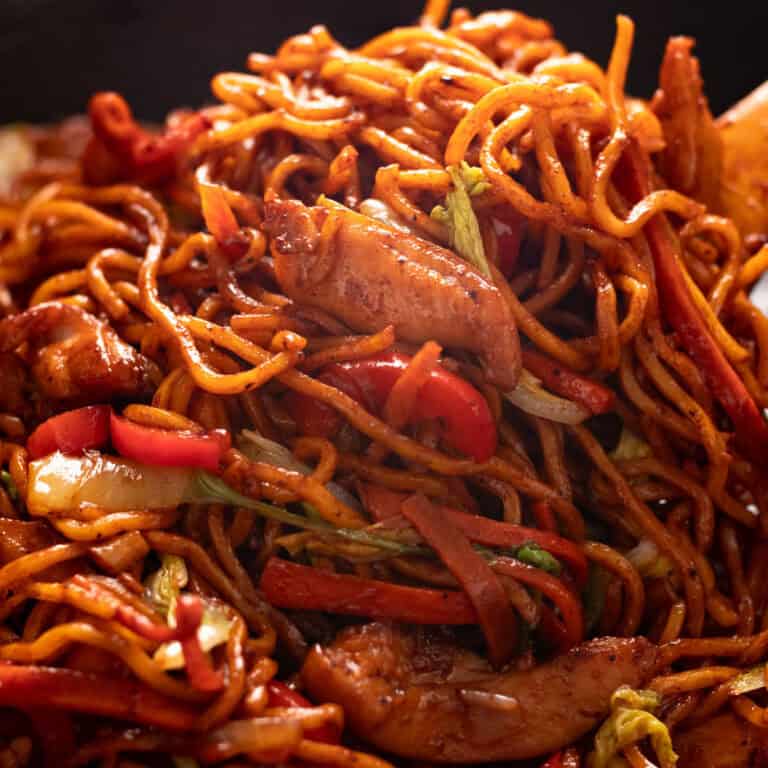Get warm & cozy with a heartwarming bowl of Sinigang na Baboy that feeds that soul. Create layers of rich flavor with this simple Pork Sinigang the fam will ask for over & over again!

This Sinigang na Baboy recipe is rich from the tender succulent pork, tangy from sour tamarind, and the ultra comfort food any rainy days you need an extra bowl of love. It’s an iconic Filipino sour soup that’s an absolute staple in Filipino cuisine!
And of course, Sinigang wouldn’t be complete without a steamy bowl of hot white rice!
If you’re craving a leaner & faster version, try my Sinigang na Salmon Belly or Chicken Sinigang. If you want EXTRA umami, don’t sleep on my Sinigang na Salmon sa Miso! And they cook up even faster than pork!
🎥 Video: Watch How to Make the Recipe
❤️ Highlights
🥘Sinigang na Baboy Ingredients

- Pork: Use your favorite cuts or pork you can get your hands. Bone-in cuts (pork ribs, pork spare ribs, or pork neck bones) create a more flavorful soup, but can be messier when eating. Fattier cuts, (like pork belly, pork shoulder, or pork butt) create a richer & super flavorful broth. Whatever cut of pork you chose, I recommend having at least a little fat so it comes out extra tender!
- Tamarind Seasoning: Nowadays, sinigang seasoning packets are easy to find, especially at an Asian supermarket or Seafood City. I’m usually partial to Mamacita’s or Knorr brands, but don’t forget to check out the “Key Tips” below for important seasoning tips! If you want more control over the sour and salty flavors in this Sinigang Baboy recipe, using homemade Tamarind Paste is the way to go, which I cover in the recipe below.
- Fish Sauce: Fish sauce adds extra saltiness (if needed) and umami. I personally love Squid fish sauce because it keeps it simple with just three basic ingredients – no mysterious preservatives or extras!
- Vegetables: For the classic Filipino sinigang, the core veggies you’ll need are onions, tomatoes, and leafy greens (bok choy is my typical go-to). In addition, I toss in string beans (sitaw) & taro root (gabi). Of course, feel free to swap out or add in any or your favorite veggies! And that’s a perfect segue to the “Variations & Substitutions” section below!
See recipe card for quantities.
📖 Variations & Substitutions
There are so many variations of sinigang!
The only way to make the “perfect” Sinigang is to make sure it has all your fave things! Here are a few different variations & variety of vegetables you can swap out or add in for a filling bowl of Sinigang.
Protein:
- Sinigang na Manok (Chicken Sinigang)
- Sinigang na Salmon Belly
- Sinigang na Salmon sa Miso
- Shrimp Sinigang (sinigang na hipon)
- Beef Sinigang (sinigang na baka)
Vegetables:
- Okra
- Sliced eggplant
- Sliced white radish
- Spinach
- Water spinach (kang kong)
- Peppers (finger, jalapeno, or other hot chilies)
Swapping Seasoning Packet for Tamarind Paste
I grew up using the Sinigang mix powder (no shame!), but the tough part about using it is if you want your Sinigang sourer, you can’t control the amount of salt added too.
*enter store-bought or homemade tamarind paste*.
Using tamarind paste (or tamarind concentrate) is made from the tamarind fruit, which is the most common souring agent used in this classic Filipino soup.
Using tamarind paste gives you much more control over the entire flavor of your Sinigang Pork!
🔪 How to Cook Sinigang na Baboy
Making Filipino sinigang is SUPER easy and comes together in 3 basic parts: making the soup base, cooking the protein through, then finishing the vegetables.
Easy peasy! Here’s how to cook pork sinigang in detail…

Step 1: Pat dry pork, then season with salt & black pepper. Heat a large pot on medium-high with a little oil, then sear for about 3-5 minutes, working in batches if needed. They should be golden brown but not cooked through, (it’ll finish cooking in the broth)!
Remove pork meat & set aside.

Step 2: Toss in diced onions & tomatoes, then saute for about 1 minute, or until they’ve softened.

Step 3: Pour in water and add pork back in. Cover & bring to a rolling bowl, then reduce to medium-low. Simmer for about 1 1/2 – 2 hours, or until pork is fork tender & cooked through.

Step 4: Add taro and string beans then cover and cook for about 5 minutes, or until they start to become tender but not soggy.

Step 5: Add in tamarind paste, fish sauce, & bok choy. Gently stir & cook until bok choy has wilted.

Step 6: Taste test the sinigang broth – if you’d like it to be sourer, add more sinigang seasoning. If it needs more salt, add more fish sauce.
Turn off heat, pour into a serving bowl, & serve with steamy hot rice. Enjoy!
👩🏽🍳 Key Tips
For Clearer Broth
For extra clear sour broth, parboiling the pork first to removes extra blood & scum from the pork & its bones. Place pork in a pot with just enough cold water to cover. Bring to a boil (about 5 minutes), drain, rinse under cold water, then follow the sinigang recipe as usual.
Don’t worry, you’re not boiling the pork long enough where you’ll need to worry about losing tons of flavor!
Boil vs Saute Methods
When making the base of the broth, you can either sautee the onions & tomatoes first OR add them into the broth directly. I prefer to sautee first to add an extra layer of flavor, but the boil method woks too.
Taste Before Adding Fish Sauce
If you decide to use sinigang seasoning packets instead of tamarind paste, keep in mind they vary from brand to brand. Before adding fish sauce, make sure to taste your soup so it doesn’t turn out too salty!
Cook Low & Slow
Once the broth is brought to a rolling boil with the pork, it’s crucial to cook the pork low & slow for succulently tender meat! If you rush, you may end up with tougher pork.
Pressure Cooker / Instant Pot Method
If you want to speed up the cooking process for this delicious Filipino pork soup, you can cook it in an Instant Pot or pressure cooker. Use the “Saute” mode to sear the seasoned pork, remove, then cook the soup base as outlined in the recipe. Add the pork into the broth, then switch to “Pressure Cook” mode. Cook for about 30-40 minutes with the vent closed, then do a quick release once finished.
Switch to “Saute” mode again, then cook the vegetables as outlined in the recipe below. Note that it’s important to cook the vegetables AFTER the pork has pressure cooked, otherwise, the vegetables will be overcooked.

💭 Recipe FAQs
🥗 More Easy Filipino Recipes You’ll Love
Let’s get cooking!
Get into my secret stash of Goody-Packed Newsletters with meals planned for you & time-saving tips! Want step-by-step videos of how to make my recipes too? I gotchu over at my youtube channel. Aight, enough chatting, more eating!

Sinigang na Baboy (Filipino Pork Sinigang Recipe)
Watch How to Make It!

Ingredients
Tamarind Paste:
- 4 ounces tamarind pulp broken into chunks
- 8 ounces boiling water
Ingredients:
- 1 ½ pounds pork* pat dry
- 2 teaspoon salt divided
- Fresh cracked pepper to taste
- ½ large onion diced
- 3 tomatoes diced
- 4 cups water
- 1/3 cup fish sauce
- ⅔ cup tamarind paste from recipe above, plus more if you like it extra sour
- 1 cup string beans cut into 3-inch pieces
- 1 cup taro sliced
- 3 cups baby bok choy leaves separated
Instructions
Make Tamarind Paste
- In a heat-proof bowl, combine the tamarind pulp and boiling water. Use a fork to gently mash the tamarind pulp. Allow to soak for at least 30 minutes.
- Use a fork to smash and loosen any remaining tamarind the fibers. Pour the tamarind paste through a sieve, using a spatula to help push it through. You can pour more water on the tamarind to help extract more of it, if needed. Set tamarind paste aside.
Make Sinigang
- Season the pork with fresh cracked pepper and ½ teaspoon of salt.
- Heat a large pot on medium-high heat, then add about a tablespoon of oil. Add the pork, working in batches if needed to avoid overcrowding. Sear the pork until browned – they don’t need to be cooked through since it’ll finish in the broth. Once browned, remove pork and set aside.
- In the same pot, add onions, tomatoes, and ½ teaspoon of salt, then saute until they begin to soften.
- Pour in broth or water, fish sauce, and pork back in. Cover and bring to a boil, then reduce the heat to medium-low and cook until the pork is fork tender, about 45 minutes.
- Increase the heat to medium-high, then add in the tamarind paste, remaining 1 teaspoon of salt, and fresh cracked black pepper. Stir and taste. Feel free to add more tamarind paste if you like it more sour or fish sauce or salt if you’d like it saltier.
- Add the taro and string beans. Stir and allow to cook for a couple of minutes, or until tender but still crisp.
- Turn off the heat then add the baby bok choy leaves. Stir into the soup until they’re wilted. Serve with hot steamy rice and enjoy!
Notes
- Pork: Use any of your fave cuts of pork. Bone-in cuts (neck bones, spare ribs, or ribs) create a super flavorful broth. Fattier boneless cuts (pork belly, shoulder, or butt) create a rich broth. You can also do a mix.
- Faster Versions:
- If you’re tight on time, you can skip the tamarind paste & using sinigang seasoning mix instead. If you do this instead, add fish sauce last & only add if you need additional salt.
- To cook the pork even faster, you can use an Instant Pot or pressure cooker. Make sure to cook the vegetables AFTER pressure cooking the pork. Scroll to the blog post above for full details.
Nutrition
Exact calculations may vary. For the most accurate nutritional information, use your preferred nutrition calculator, actual ingredients, and quantities used for the recipe. Please consult with your physician or registered dietitian if more precise nutrition calculations are needed for health reasons.









